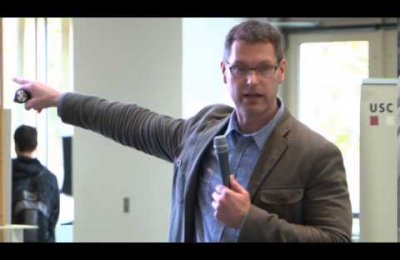In a just-released national survey leading up to the Republican National Convention, President Barack Obama and Vice President Joe Biden lead the Republican ticket of Mitt Romney and Paul Ryan by a slim margin of 48-46 among likely voters, with just 3 percent of voters undecided.
These results from the USC Annenberg-Los Angeles Times Poll on Politics and the Press — which surveyed 1,009 registered voters nationwide from August 13-19 — are within one point of how Obama and Romney perform head-to-head, with Obama edging Romney 49-46 without their running mates.
Overall, the Democratic ticket leads 51-41 among younger voters, and the Republican ticket leads 50-45 among voters over the age of 49.
By gender, Obama/Biden lead Romney/Ryan 51-43 among women voters, while Romney/Ryan lead among men, 48-44. By ethnicity, the incumbents lead 76-17 among minority voters, and Romney/Ryan lead 55-39 among white voters. Ninety-two percent of black voters and 68 percent of Latino voters support Obama/Biden, while 2 percent of black voters and 27 percent of Latino voters support Romney/Ryan.
Voters are similarly split by income, with those earning less than $50,000 a year supporting Obama/Biden by a margin of 55-40, and those earning more than $50,000 a year supporting Romney/Ryan by a margin of 52-43, according to the results of the USC Annenberg-Los Angeles Times Poll on Politics and the Press.
“Heading into the conventions, for all practical purposes, this race is tied,” said Dan Schnur, director of the Unruh Institute of Politics at USC. “But there are deep differences between the two candidates’ bases of support on age, gender and ethnicity.”
“This country is divided along stark demographic lines — and there’s almost nobody left in the middle,” Schnur said.
The USC Annenberg-Los Angeles Times Poll on Politics and the Press also asked how voters get their news. Additional survey results will be released Friday on media consumption habits and whether voters trust news outlets such as CNN, MSNBC, Fox News, national newspapers and Facebook.
Eighty percent of the registered voters surveyed by the USC Annenberg-Los Angeles Times Poll on Politics and the Press said they were following election news closely.
But there was a generation gap in how voters learned that Mitt Romney had selected Wisconsin Rep. Ryan as his running mate.
A majority of likely voters – 53 percent – said they first heard the news on television, and older voters were 23 percentage points more likely to have heard the news this way than younger voters: 62 percent of voters over the age of 49 found out about Ryan’s selection on television, compared to 39 percent of voters aged 18-29.
Younger voters were much more likely to have learned about Ryan’s selection online. More than a third of voters 18-49 first heard of Ryan’s selection on a computer, smartphone or tablet — more than double the 17 percent of voters over the age of 49.
Among all likely voters, 21 percent heard about Ryan’s selection on the Internet, compared to 11 percent who got the news on the radio, 5 percent who heard about it through word-of-mouth, 4 percent who learned the news on a smartphone, and 3 percent who got the news from a print newspaper.
Of those who learned that Ryan would the Republican vice presidential nominee online, 35 percent of likely voters got the news via an email from a news organization, 17 percent found out on Facebook, and 7 percent got the news on Twitter.
“These findings underscore the need for well-trained journalists at every level," says Geoffrey Cowan, USC University Professor and director of the USC Annenberg Center on Communication Leadership & Policy. "Our question about how voters learned about the selection of Paul Ryan as the vice presidential candidate documents the growing use of digital and social media as a source for breaking news and analysis, especially among younger voters.”
The USC Annenberg-Los Angeles Times Poll on Politics and the Press also surveyed voters about President George W. Bush’s tax cuts, which were extended by President Obama and are set to expire at the end of the year. Forty-three percent of likely voters said the tax cuts should be kept in place for those making less than $250,000 a year, but not for high earners. Thirty-seven percent said the tax cuts should remain at all income levels, and 13 percent said the tax cuts should be allowed to expire.
On the issue of immigration, 61 percent of likely voters favored President Obama’s proposal to allow illegal immigrants who were brought to the U.S. as children to gain legal resident status if they complete two years of military service or college and have no criminal record. Thirty percent of voters opposed the proposal.
Overall, President Obama’s favorability rating is 53-45, buoyed by the 82 percent of minority voters who said they had a favorable view of the President. Forty-three percent of white voters nationwide have a favorable view of Obama, and 55 percent have an unfavorable view.
Romney’s favorability is split at 45-48, with 52 percent of white voters viewing him favorably and 42 percent viewing him unfavorably. Among minority voters, 27 percent have a favorable view of Romney and 67 percent have an unfavorable view.
Nearly 1 in 4 voters were unable to identify Ryan, with 39 percent of voters who know who he is having a favorable view and 32 percent having an unfavorable view.
The full sample of 1,009 registered voters has a margin of error of +/- 3.1 percentage points.
The USC Annenberg-Los Angeles Times Poll on Politics and the Press is a project of the USC Annenberg Center on Communication Leadership & Policy. The poll was conducted on behalf of USC and the Los Angeles Times by Republican polling firm American Viewpoint and Democratic polling firm Greenberg Quinlan Rosner.
For more results, crosstabs and poll methodology, visit http://www.gqrr.com/index.php?ID=2780
EVENT: Politics & the Media: Bridging the Political Divide at the 2012 Republican National Convention
Sunday, August 26, 2 p.m.
New York Times executive editor Jill Abramson joins Restore our Future founder and treasurer Charles Spies for a conversation moderated by Bloomberg News Washington editor Al Hunt. The program includes a presentation by Dan Schnur, director of the USC Unruh Institute of Politics and David Lauter, Washington bureau chief for the Los Angeles Times on findings from the new USC Annenberg-Los Angeles Times Poll on Politics and the Press.
Reception follows the program. This is a free event; advance registration is required. Click here to register or write commlead@usc.edu
Location: Bloomberg Link, Tampa, Florida
Webcast: The event will be webcast live here.
The conversation and research presentation at the Republican National Convention in Tampa, Florida is presented by the USC Annenberg Center on Communication Leadership & Policy, in partnership with Bloomberg and Harvard's Institute of Politics.
EVENT: Politics & the Media: Bridging the Political Divide at the 2012 Democratic National Convention
Monday, September 3, 2 p.m.
Washington Post executive editor Marcus Brauchli, New York Times Magazine political correspondent Matt Bai, Obama for America press secretary Ben LaBolt and YouTube news and politics manager Olivia Ma join a conversation moderated by Bloomberg News Washington editor Al Hunt. The program includes a presentation by Dan Schnur, director of the USC Unruh Institute of Politics and David Lauter, Washington bureau chief for the Los Angeles Times on findings from the new USC Annenberg-Los Angeles Times Poll on Politics and the Press.
Reception follows the program. This is a free event; advance registration is required. Click here to register or write commlead@usc.edu
Location: Bloomberg Link, Charlotte, North Carolina
Webcast: This event will be webcast live here.
The conversation and research presentation at the Democratic National Convention in Charlotte, North Carolina is presented by the USC Annenberg Center on Communication Leadership & Policy, in partnership with Bloomberg and Harvard's Institute of Politics.








